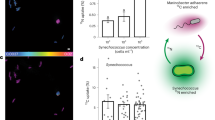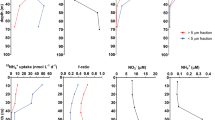Abstract
Synechococcus accounts for a considerable proportion of oceanic carbon fixation and has close relation with heterotrophic bacteria at sub-micrometre scales. However, the relationship between Synechococcus and heterotrophic bacteria and their impacts on oceanic carbon flow is not well understood. Here, we separately co-cultured the heterotrophic bacterial community with two different axenic Synechococcus strains, i.e. Synechococcus sp. PCC7002 and Synechococcus sp. CCMP1334. The dissolved organic carbon (DOC) released by Synechococcus promoted the rapid growth of heterotrophic bacteria. Due in part to the slight differences in the Synechococcus-derived DOC composition, the starting heterotrophic bacterial community was reshaped by the two Synechococcus strains into significantly divergent community structures, suggesting that different heterotrophic bacterial communities may gather around different Synechococcus strains and interact with each other in the oceans. Interestingly, the two Synechococcus strains also released some very stable humic-like DOC components that resisted use by heterotrophic bacteria and were gradually accumulated in seawater, implying that in addition to photosynthetic carbon fixation, Synechococcus may also play an important role in long-term ocean carbon sequestration by producing relatively recalcitrant DOC. Moreover, the interactions of Synechococcus and the heterotrophic bacterial communities could increase aggregate formation and particle sinking, which can likely enhance the contribution of Synechococcus to the magnitude of the sinking biological carbon pump in the oceans.






Similar content being viewed by others
Data availability
The sequences used in the study have been deposited into the NCBI Sequence Read Archive and are available under the accession number PRJNA637938.
References
Azam F, Malfatti F (2007) Microbial structuring of marine ecosystems. Nat Rev Microbiol 5:782–791
Azam F, Fenchel T, Field J, Gray J, Meyer-Reil L, Thingstad F (1983) The ecological role of water-column microbes in the sea. Mar Ecol Prog Ser 10:257–263
Biller SJ, Berube PM, Lindell D, Chisholm SW (2015) Prochlorococcus: the structure and function of collective diversity. Nat Rev Microbiol 13:13–27
Bridgeman J, Bieroza M, Baker A (2011) The application of fluorescence spectroscopy to organic matter characterisation in drinking water treatment. Rev Environ Sci Biotechnol 10:277–290
Buitenhuis ET, Li WKW, Vaulot D, Lomas MW, Landry MR, Partensky F, Karl DM, Ulloa O, Campbell L, Jacquet S, Lantoine F, Chavez F, Macias D, Gosselin M, McManus GB (2012) Picophytoplankton biomass distribution in the global ocean. Earth Syst Sci Data 4:37–46
Cavicchioli R, Ripple WJ, Timmis KN, Azam F, Bakken LR, Baylis M, Behrenfeld MJ, Boetius A, Boyd PW, Classen AT, Crowther TW, Danovaro R, Foreman CM, Huisman J, Hutchins DA, Jansson JK, Karl DM, Koskella B, Mark Welch DB, Martiny JBH, Moran MA, Orphan VJ, Reay DS, Remais JV, Rich VI, Singh BK, Stein LY, Stewart FJ, Sullivan MB, van Oppen MJH, Weaver SC, Webb EA, Webster NS (2019) Scientists’ warning to humanity: microorganisms and climate change. Nat Rev Microbiol 17:569–586
Chen J, Li H, Zhang Z, He C, Shi Q, Jiao N, Zhang Y (2020) DOC dynamics and bacterial community succession during long-term degradation of Ulva prolifera and their implications for the legacy effect of green tides on refractory DOC pool in seawater. Water Res 185:116268
Chisholm SW (2000) Oceanography: stirring times in the Southern Ocean. Nature 407:685–687
Cirri E, Pohnert G (2019) Algae-bacteria interactions that balance the planktonic microbiome. New Phytol 223:100–106
Coble PG, Del Castillo CE, Avril B (1998) Distribution and optical properties of CDOM in the Arabian Sea during the 1995 Southwest Monsoon. Deep-Sea Res II 45:2195–2223
Cole (1982) Interactions between bacteria and algae in aquatic ecosystems. Annu Rev Ecol Syst 13:291–314
Cruz BN, Neuer S (2019) Heterotrophic bacteria enhance the aggregation of the marine picocyanobacteria Prochlorococcus and Synechococcus. Front Microbiol 10:1864
Edgar RC (2016) UNOISE2: improved error-correction for Illumina 16S and ITS amplicon sequencing. bioRxiv:081257 https://doi.org/10.1101/081257
Field CB, Behrenfeld MJ, Randerson JT, Falkowski P (1998) Primary production of the biosphere: integrating terrestrial and oceanic components. Science 281:237–240
Fox BG, Thorn RMS, Anesio AM, Reynolds DM (2017) The in situ bacterial production of fluorescent organic matter; an investigation at a species level. Water Res 125:350–359
Gaerdes A, Iversen MH, Grossart H-P, Passow U, Ullrich MS (2011) Diatom-associated bacteria are required for aggregation of Thalassiosira weissflogii. ISME J 5:436–445
Giovannoni SJ, Stingl U (2005) Molecular diversity and ecology of microbial plankton. Nature 437:343–348
Grossart HP, Czub G, Simon M (2006) Algae–bacteria interactions and their effects on aggregation and organic matter flux in the sea. Environ Microbiol 8:1074–1084
Guidi L, Chaffron S, Bittner L, Eveillard D, Larhlimi A, Roux S, Darzi Y, Audic S, Berline L, Brum J, Coelho LP, Espinoza JCI, Malviya S, Sunagawa S, Dimier C, Kandels-Lewis S, Picheral M, Poulain J, Searson S, Tara Oceans C, Stemmann L, Not F, Hingamp P, Speich S, Follows M, Karp-Boss L, Boss E, Ogata H, Pesant S, Weissenbach J, Wincker P, Acinas SG, Bork P, de Vargas C, Iudicone D, Sullivan MB, Raes J, Karsenti E, Bowler C, Gorsky G (2016) Plankton networks driving carbon export in the oligotrophic ocean. Nature 532:465–470
Guo R, Liang Y, Xin Y, Wang L, Mou S, Cao C, Xie R, Zhang C, Tian J, Zhang Y (2018) Insight into the pico- and nano-phytoplankton communities in the deepest biosphere, the Mariana Trench. Front Microbiol 9:02289
Jardillier L, Zubkov MV, Pearman J, Scanlan DJ (2010) Significant CO2 fixation by small prymnesiophytes in the subtropical and tropical northeast Atlantic Ocean. ISME J 4:1180–1192
Jiao N, Herndl GJ, Hansell DA, Benner R, Kattner G, Wilhelm SW, Kirchman DL, Weinbauer MG, Luo T, Chen F, Azam F (2010) Microbial production of recalcitrant dissolved organic matter: long-term carbon storage in the global ocean. Nat Rev Microbiol 8:593–599
Josefsen MH, Andersen SC, Christensen J, Hoorfar J (2015) Microbial food safety: Potential of DNA extraction methods for use in diagnostic metagenomics. J Microbiol Methods 114:30–34
Kinsey JD, Corradino G, Ziervogel K, Schnetzer A, Osburn CL (2018) Formation of chromophoric dissolved organic matter by bacterial degradation of phytoplankton-derived aggregates. Front Mar Sci 4:00430
Kozich JJ, Westcott SL, Baxter NT, Highlander SK, Schloss PD (2013) Development of a dual-index sequencing strategy and curation pipeline for analyzing amplicon sequence data on the MiSeq Illumina sequencing platform. Appl Environ Microbiol 79:5112–5120
Kramer GD, Herndl GJ (2004) Photo-and bioreactivity of chromophoric dissolved organic matter produced by marine bacterioplankton. Aquat Microb Ecol 36:239–246
Liang Y, Zhang Y, Zhang Y, Luo T, Rivkin RB, Jiao N (2016) Distributions and relationships of virio- and picoplankton in the epi-, meso- and bathypelagic zones of the Western Pacific Ocean. FEMS Microbiol Ecol 93. https://doi.org/10.1093/femsec/fiw238
Liu J, Jiao N, Tang K (2014) An experimental study on the effects of nutrient enrichment on organic carbon persistence in the western Pacific oligotrophic gyre. Biogeosciences 11:5115–5122
Ludwig M, Bryant D (2011) Transcription profiling of the model cyanobacterium Synechococcus sp. strain PCC 7002 by Next-Gen (SOLiD™) sequencing of cDNA. Front Microbiol 2 https://doi.org/10.3389/fmicb.2011.00041
Malfatti F, Azam F (2009) Atomic force microscopy reveals microscale networks and possible symbioses among pelagic marine bacteria. Aquat Microb Ecol 58:1–14
Malfatti F, Samo TJ, Azam F (2010) High-resolution imaging of pelagic bacteria by atomic force microscopy and implications for carbon cycling. ISME J 4:427–439
Murphy KR, Butler KD, Spencer RG, Stedmon CA, Boehme JR, Aiken GR (2010) Measurement of dissolved organic matter fluorescence in aquatic environments: an interlaboratory comparison. Environ Sci Technol 44:9405–9412
Powell RJ, Hill RT (2013) Rapid aggregation of biofuel-producing algae by the bacterium Bacillus sp. strain RP1137. Appl Environ Microbiol 79 https://doi.org/10.1128/AEM.01496-13
Quast C, Pruesse E, Yilmaz P, Gerken J, Schweer T, Yarza P, Peplies J, Glockner FO (2013) The SILVA ribosomal RNA gene database project: improved data processing and web-based tools. Nucleic Acids Res 41:D590–D596
Rippka R, Stanier RY, Deruelles J, Herdman M, Waterbury JB (1979) Generic assignments, strain histories and properties of pure cultures of cyanobacteria. J Gen Microbiol 111:1–61
Romera-Castillo C, Sarmento H, Alvarez-Salgado XA, Gasol JM, Marrase C (2011) Net production and consumption of fluorescent colored dissolved organic matter by natural bacterial assemblages growing on marine phytoplankton exudates. Appl Environ Microbiol 77:7490–7498
Sarmento H, Morana C, Gasol JM (2016) Bacterioplankton niche partitioning in the use of phytoplankton-derived dissolved organic carbon: quantity is more important than quality. ISME J 10:2582–2592
Scully N, Lean D (1994) The attenuation of ultraviolet radiation in temperate lakes. Erg Limnol 43:135–135
Seymour JR, Ahmed T, Durham WM, Stocker R (2010) Chemotactic response of marine bacteria to the extracellular products of Synechococcus and Prochlorococcus. Aquat Microb Ecol 59:161–168
Seymour JR, Amin SA, Raina J-B, Stocker R (2017) Zooming in on the phycosphere: the ecological interface for phytoplankton–bacteria relationships. Nat Microbiol 2:17065
Sonnenschein EC, Syit DA, Grossart H-P, Ullrich MS (2012) Chemotaxis of Marinobacter adhaerens and its impact on attachment to the diatom Thalassiosira weissflogi. Appl Environ Microbiol 78:6900–6907
Stedmon CA, Bro R (2008) Characterizing dissolved organic matter fluorescence with parallel factor analysis: a tutorial. Limnol Oceanogr 6:572–579
Waterbury JB, Watson SW, Valois FW, Franks DG (1986) Biological and ecological characterization of the marine unicellular cyanobacterium Synechococcus. In: Platt T, Li WKW (eds) Photosynthetic Picoplankton. Canadian Department of Fisheries and Oceans, Ottawa, pp 71–120
Wei Y, Sun J, Zhang X, Wang J, Huang K (2019) Picophytoplankton size and biomass around equatorial eastern Indian Ocean. MicrobiologyOpen 8:e00629
Yamashita Y, Jaffé R, Maie N, Tanoue E (2008) Assessing the dynamics of dissolved organic matter (DOM) in coastal environments by excitation emission matrix fluorescence and parallel factor analysis (EEM-PARAFAC). Limnol Oceanogr 53:1900–1908
Zhang Y, Zhang J, Liang Y, Li H, Li G, Chen X, Zhao P, Jiang Z, Zou D, Liu X, Liu J (2017a) Carbon sequestration processes and mechanisms in coastal mariculture environments in China. Sci China Earth Sci 60:2097–2107
Zhang Y, Zhao M, Cui Q, Fan W, Qi J, Chen Y, Zhang Y, Gao K, Fan J, Wang G, Yan C, Lu H, Luo Y, Zhang Z, Zheng Q, Xiao W, Jiao N (2017b) Processes of coastal ecosystem carbon sequestration and approaches for increasing carbon sink. Sci China Earth Sci 60:809–820
Zhang Y, He P, Li H, Li G, Liu J, Jiao F, Zhang J, Huo Y, Shi X, Su R, Ye N, Liu D, Yu R, Wang Z, Zhou M, Jiao N (2019) Ulva prolifera green-tide outbreaks and their environmental impact in the Yellow Sea, China. Natl Sci Rev 6:825–838
Zhao Z, Gonsior M, Luek J, Timko S, Ianiri H, Hertkorn N, Schmitt-Kopplin P, Fang X, Zeng Q, Jiao N, Chen F (2017) Picocyanobacteria and deep-ocean fluorescent dissolved organic matter share similar optical properties. Nat Commun 8:15284
Zhao Z, Gonsior M, Schmitt-Kopplin P, Zhan Y, Zhang R, Jiao N, Chen F (2019) Microbial transformation of virus-induced dissolved organic matter from picocyanobacteria: coupling of bacterial diversity and DOM chemodiversity. ISME J 13:2551–2565
Zheng Q, Chen Q, Cai R, He C, Guo W, Wang Y, Shi Q, Chen C, Jiao N (2019) Molecular characteristics of microbially mediated transformations of Synechococcus-derived dissolved organic matter as revealed by incubation experiments. Environ Microbiol 21:2533–2543
Funding
This work was supported by the National Key Research and Development Program of China (2016YFA0601402), the Senior User Project of RV KEXUE (KEXUE2019GZ03) supported by Center for Ocean Mega-Science, Chinese Academy of Sciences, NSFC projects (no. 31700104, U1906216), a Key R&D projects in Shandong Province (2019GHY112037), the DICP&QIBEBT (DICP&QIBEBT UN201803), the QIBEBT (QIBEBT ZZBS 201805), Dalian National Laboratory For Clean Energy (DNL), CAS, and Key Lab of Marine Bioactive Substance and Modern Analytical Technique, SOA (MBSMAT-2018-02). This study is a contribution to the international IMBER project.
Author information
Authors and Affiliations
Contributions
Zenghu Zhang: formal analysis, visualization, writing—original draft. Lili Tang: investigation, validation, writing—original draft. Yantao Liang: methodology. Gang Li: writing—review and editing. Hongmei Li: methodology. Richard B. Rivkin: validation. Nianzhi Jiao: supervision. Yongyu Zhang: conceptualization, supervision, writing—review and editing.
Corresponding author
Ethics declarations
Conflict of interest
The authors declare that they have no conflict of interest.
Additional information
Publisher’s note
Springer Nature remains neutral with regard to jurisdictional claims in published maps and institutional affiliations.
Rights and permissions
About this article
Cite this article
Zhang, Z., Tang, L., Liang, Y. et al. The relationship between two Synechococcus strains and heterotrophic bacterial communities and its associated carbon flow. J Appl Phycol 33, 953–966 (2021). https://doi.org/10.1007/s10811-020-02343-6
Received:
Revised:
Accepted:
Published:
Issue Date:
DOI: https://doi.org/10.1007/s10811-020-02343-6




